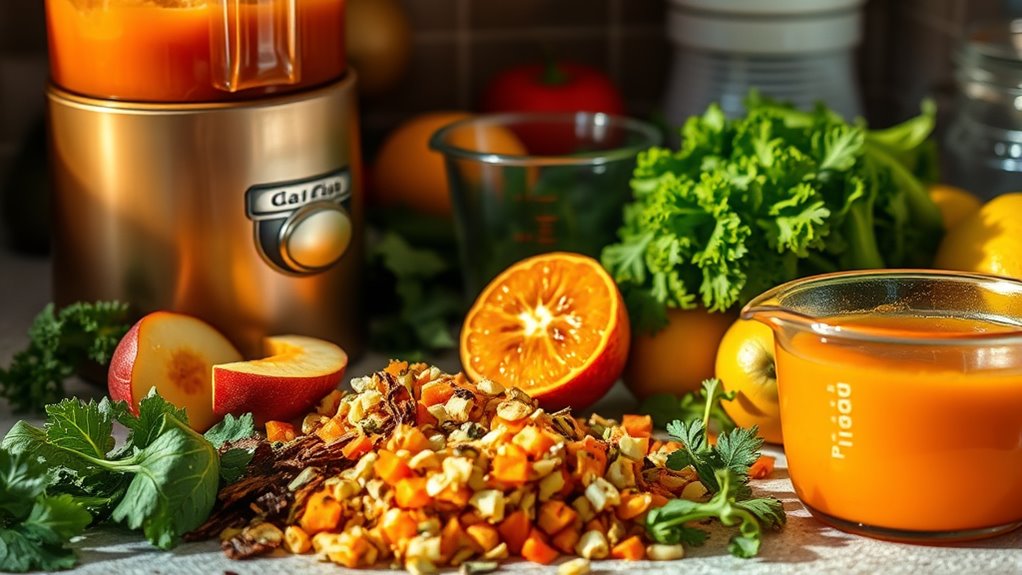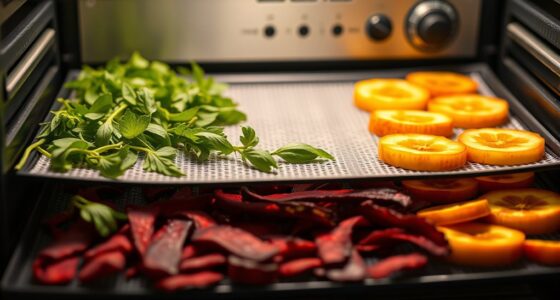To avoid common juicing mistakes, choose a variety of fruits and vegetables, not just overly sweet or colorful ones, to guarantee balanced nutrition. Don’t discard pulp; adding it back boosts fiber and reduces waste. Complement your juice with protein and healthy fats for sustained energy. Proper storage and immediate consumption preserve nutrients. By addressing these pitfalls, you’ll maximize health benefits—and there’s more to discover to perfect your juicing routine.
Key Takeaways
- Choose a variety of fruits and vegetables, including greens and berries, to ensure balanced nutrition and avoid excessive sugar intake.
- Manage pulp by adding it to smoothies or baked goods, maximizing fiber intake and reducing waste.
- Pair juice with proteins, nuts, or seeds to balance nutrients and prevent blood sugar spikes.
- Consume fresh juice immediately or store properly in airtight containers for up to 24 hours to preserve nutrients.
- Avoid relying solely on juice; include whole foods and other nutrient sources for comprehensive health benefits.

Are you making common mistakes when juicing that could be sabotaging your health goals? One of the biggest pitfalls is poor fruit selection. When choosing fruits for your juice, it’s tempting to go for the most colorful or sweet options, but that can lead to imbalanced nutrition. Opt for a variety of fruits, including leafy greens, berries, citrus, and even vegetables. This diversity ensures you’re getting a wide range of vitamins, minerals, and antioxidants, which are essential for excellent health. Relying heavily on one or two sweet fruits, like apples or grapes, can spike your sugar intake and diminish the health benefits. Instead, focus on fruits that complement each other in flavor and nutrient profile, and don’t forget to include some that are lower in sugar to keep your blood sugar levels stable.
Choose a variety of fruits and vegetables for balanced, nutritious juices.
Another mistake many people make involves pulp management. When you juice, you’re often left wondering what to do with the pulp—throw it away, or incorporate it into your diet? Proper pulp management can maximize the nutrients in your juice and reduce waste. Instead of discarding all the pulp, consider adding some back into your juice or using it in other recipes like smoothies, baked goods, or even soups. This not only boosts fiber intake but also enhances the texture and flavor of your creations. Fibrous pulp helps regulate digestion, keeps you feeling full longer, and supports overall gut health. If you prefer a smoother juice, invest in a high-quality juicer that separates pulp more efficiently, but don’t let it go entirely to waste. Incorporating pulp into your diet is a simple, effective way to enhance your juicing routine.
It’s also common to ignore the importance of balancing your juice with other nutrients. Even if your fruit selection is spot-on, relying solely on juice can lead to missing out on proteins and healthy fats. To get the most out of your juicing efforts, pair your fresh juice with snacks or meals that include nuts, seeds, or yogurt. This combination helps stabilize blood sugar and provides sustained energy throughout your day.
Additionally, understanding the history of pinball machines can inspire you to incorporate playful elements into your wellness routine, making health habits more engaging and enjoyable. Finally, don’t overlook the significance of proper storage and timing. Freshly made juice is best enjoyed immediately to preserve nutrients, but if you need to store it, use airtight containers and keep it refrigerated for no more than 24 hours. This prevents oxidation and nutrient loss. By paying attention to your fruit selection, managing pulp wisely, balancing your diet, and storing your juice properly, you’ll avoid common mistakes that can undermine your health goals. Juicing should be a positive addition to your lifestyle, not a source of frustration or nutritional gaps.
Frequently Asked Questions
Can I Juice Frozen Fruits and Vegetables Effectively?
Yes, you can juice frozen fruits and vegetables effectively. Using frozen produce helps preserve their texture and nutrients, making your juice rich and flavorful. Just let the frozen items thaw slightly or run them through your juicer directly from the freezer, depending on your machine. Keep in mind that some textures might be more challenging, so blending first can help, ensuring you get the most out of your frozen ingredients.
How Do I Store Fresh Juice for Later Consumption?
To store fresh juice for later, you should use airtight storage containers to preserve its freshness and prevent oxidation. Fill them up to minimize air contact, and keep the juice refrigerated immediately. For ideal juice preservation, consume it within 24-48 hours. If you want to keep it longer, consider freezing it in suitable containers, but be aware that freezing may slightly affect the texture and flavor.
Are There Specific Fruits or Vegetables to Avoid Juicing?
Did you know that over 90% of people juice fruits or vegetables that aren’t ideal? You should avoid juicing toxic produce like unwashed or contaminated items and steer clear of overripe ingredients, as they can spoil your juice or cause digestive issues. Fruits with high sugar content, like bananas or avocados, aren’t suitable for juicing and might clog your juicer. Stick to fresh, ripe produce for the best, safe results.
What’s the Best Way to Clean My Juicer Thoroughly?
To clean your juicer thoroughly, start with cleaning techniques like disassembling all parts and rinsing them under warm water immediately after use. Use a brush to scrub stubborn pulp from screens and blades. For sanitization tips, soak removable parts in a mixture of water and vinegar or mild soap, then rinse well. Dry all components completely before reassembling to prevent mold and bacteria growth, ensuring your juicer stays fresh and safe.
How Can I Enhance Juice Flavor Without Adding Sugar?
Ever wondered how to boost your juice’s flavor naturally? You can enhance the taste with natural flavor enhancement by adding fresh herbs like mint or basil, which bring a vibrant twist. Spice infusion, such as a dash of cinnamon or ginger, also elevates flavors without sugar. These simple tricks deepen your juice’s complexity and make every sip more enjoyable, all while keeping it healthy and naturally delicious.
Conclusion
By steering clear of these common juicing mistakes, you’ll transform your kitchen into a vibrant juice bar. Imagine pouring a glass of fresh, lively juice that energizes your day, not one filled with hidden pitfalls. With mindful choices, your juice becomes a nourishing splash of nature’s best, fueling your body and brightening your mornings. So, embrace these tips, and let each glass you pour be a invigorating reminder of the healthy, flavorful journey you’re on.









